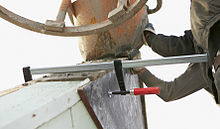Screw clamp
A screw clamp is a clamping device for pressing and holding several workpieces together during processing. Large screw clamps are also known as screw jacks . Clamping clamps are also used as an alternative for quick clamping and releasing as well as for applications that only require a low pressure force .
A screw clamp consists of a fixed clamp arm and a clamp arm that can be moved on a rail . A threaded spindle with a wooden or plastic handle or toggle and a movable ball pressure plate leads through the movable arm . When clamping, the fixed clamping arm is first placed on the workpiece to be clamped and roughly fixed by moving the movable clamping arm. The clamping arm tilts on the guide. By means of appropriate dimensions and the appropriate choice of material, the self-locking that then occurs and which is intended by the design prevents further movement on the rail. Fine adjustment and pressing with high force is done by tightening the threaded spindle. In addition to designs with malleable cast iron fixed and sliding brackets on mostly corrugated steel rails and all-steel clamps, in which the rail and fixed bracket consist of one part and, like the sliding bracket, are made of steel. The most common types of screw clamps are listed below:
- The malleable cast iron screw clamps , in which the slide rail is made of steel. This type of clamp is cheaper than an all-steel clamp. With rigid clamping, a high clamping force can be achieved with it and is therefore particularly suitable for gluing components such as board surfaces.
- The all-steel clamps, slide rail, slide and fixed bracket are made of steel. Due to the material and the manufacture of the slide rail and fixed bracket from a continuous piece of steel, this type of clamp is of very high quality and, in contrast to the malleable cast iron clamp, absorbs vibrations very well. An all-steel clamp is particularly suitable for work in which the workpiece must be optimally fixed.
- One-hand clamps can also be operated with just one hand if necessary. They are therefore particularly suitable for one-person work. This type of clamp can be used in many ways and is often quite cheap to buy compared to a malleable cast iron or all-steel clamp. The disadvantage of a one-handed clamp is that it cannot exert as much force as the other types of clamps.
- Parallel screw clamps have a double spindle guide so that the clamping surfaces always move exactly in parallel and the workpieces do not move against each other. A parallel screw clamp is usually made entirely of steel.
- Edge clamps are special screw clamps with which a second workpiece is pressed onto the edges of a workpiece, whereby the main workpiece is only supported with a force fit.
- The door clamp is used to glue doors and table tops. It consists of a steel rail on which a pressure and sliding jaw that can be moved by means of a screw spindle is attached.
- Deep clamping screw clamps with a particularly high clamping depth / projection of 200 to 400 mm.
In woodworking , screw clamps are used, among other things, to glue components together. In order to avoid pressure points on the workpieces, the contact surfaces are often provided with plastic caps, however, to distribute the force evenly and with soft materials, wooden or similar elements are used. Supplements may also be necessary to compensate for inclined or curved surfaces of the workpiece so that the clamp does not slip.
Until the early 20th century, screw clamps made of wood were common in which both arms were immobile, so the wooden spindle had to be particularly long to reach over the entire space between the two fixed arms. Nevertheless, these screw clamps usually had a smaller span than the metal models with sliding arm that are common today.
Web links
Individual evidence
- ↑ a b Wolfgang Nutsch and others: Fachkunde für Schreiner (12th edition), Verlag Europa-Lehrmittel, Wuppertal 1980, page 257, ISBN 3-8085-4011-7
- ↑ Otto Werkmeister: The ax in the house . Verlag Mensch und Arbeit Robert Pfützner GmbH, Munich 1956, 1967, 1972, 1974, p. 105
- ↑ M. Hoße, C. Dahl, H.-D. Schäller and J. Schnitzer: Lexicon of the model railway, 6th edition . transpress, Stuttgart 1998, p. 180, ISBN 3-344-70755-8
- ↑ a b Karl Göttlich: Wood ABC. Fachbuchverlag, Leipzig 1957, p. 170 f.


